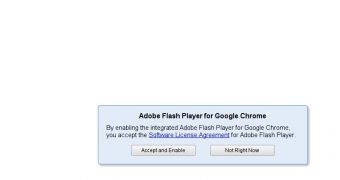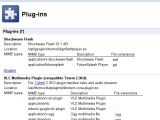The rumors yesterday tuned out to be accurate, Google has just announced a deeper integration of the Adobe Flash Player in Chrome. Specifically, the latest development builds now come bundled with the Flash Player, though the feature is not enabled by default. Google says this path is more convenient for users, who don't have to download and install the plug-in separately, but there aren't that many other benefits at this moment. Google Chrome 5.0.360.4 dev for Windows and Mac and Google Chrome 5.0.360.5 dev for Linux now come with the Flash plug-in pre-installed.
"The traditional browser plug-in model has enabled tremendous innovation on the web, but it also presents challenges for both plug-ins and browsers. The browser plug-in interface is loosely specified, limited in capability and varies across browsers and operating systems," Linus Upson, VP Engineering at Google, wrote.
"That’s why we are working with Adobe, Mozilla and the broader community to help define the next generation browser plug-in API. This new API aims to address the shortcomings of the current browser plug-in model. There is much to do and we’re eager to get started. As a first step, we’ve begun collaborating with Adobe to improve the Flash Player experience in Google Chrome," he announced.
Google Chrome 5.0.360.4/5 dev
Google Chrome 5.0.360.4/5 dev is a very small update focused exclusively on the new plug-in integration. It bundles the latest Adobe Flash Player 10.1.51.95 (10.1 beta 3) and comes with a basic plug-in manager that allows you to see all the installed and active plug-ins. The integrated Flash Player is not enabled by default. You have to launch Chrome with the --enable-internal-flash command line switch to get the integrated plug-in instead of the global one you may already have installed on your system.
The new plug-in manager lists all the plug-ins you have installed, like video players, Java and Adobe Flash, of course. You can disable any of them, for troubleshooting, for example, and also see where they are installed and what MIME types they handle. It is the first iteration of the newly integrated Flash plug-in, so there are still some issues. The plug-in may be enabled even if you decline the license agreement or specifically disable it in the manager. The integrated plug-in is not available for 64-bit Linux users.
Google says that integrating Adobe Flash saves users the hassle of having to download and install it manually, which can be a problem especially on some Linux systems. There is also the added benefit of having the plug-in updated automatically using Google Chrome's existing update system. The Chrome developers will work with Adobe engineers to make Flash play nice with Chrome's sandbox environment, which isolates web pages from each other and from other software or system components that may be running. The sandbox is one of Chrome's most touted features and is a big improvement to browser security and stability.
Next-generation NPAPI
Google says this is just the first step in creating a "next-generation browser plug-in API," which is currently being discussed by Mozilla along with Adobe and "the broader community." Mozilla is proposing an overhaul of the rather ancient NPAPI (Netscape Plugin Application Programming Interface) on which all platform-independent plug-ins are based today. The changes would create a safer and more secure platform and also provide more advanced functionality. The project is at the very early stages.
Google Chrome 5.0.360.4 for Windows is available for download here. Google Chrome 5.0.360.4 for Mac is available for download here. Google Chrome 5.0.360.5 for Linux is available for download here.

 14 DAY TRIAL //
14 DAY TRIAL // 
